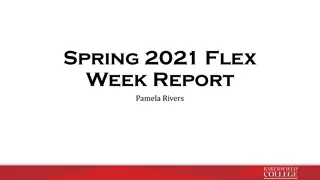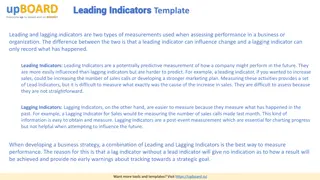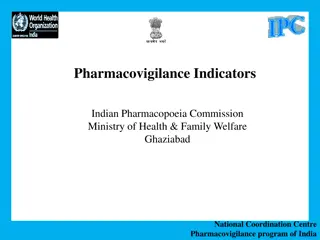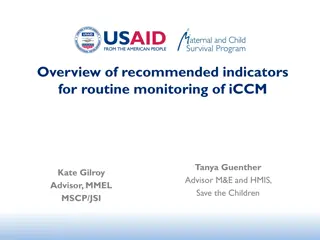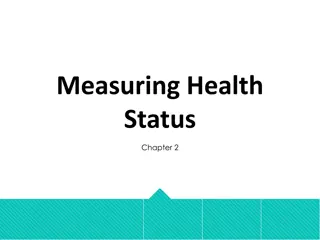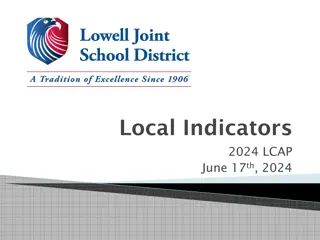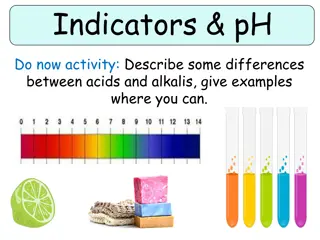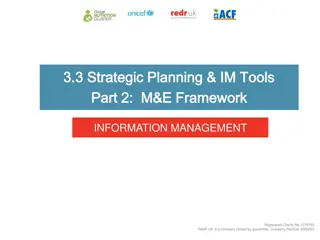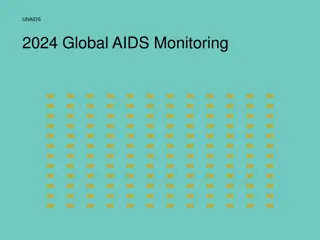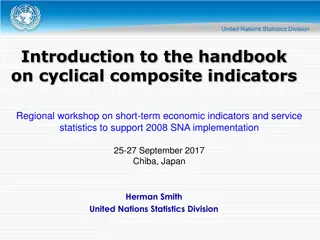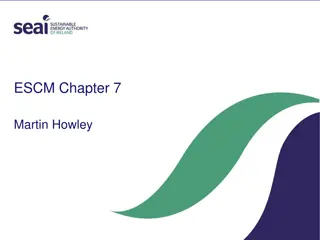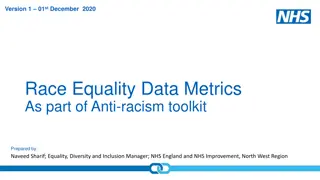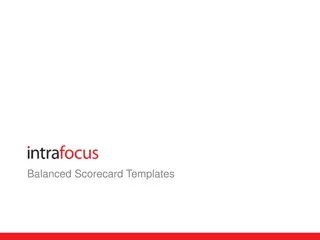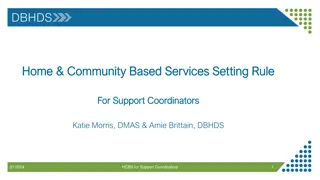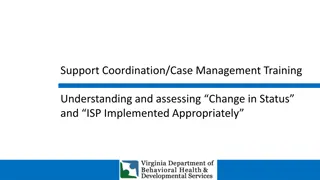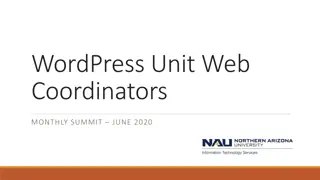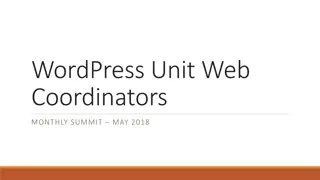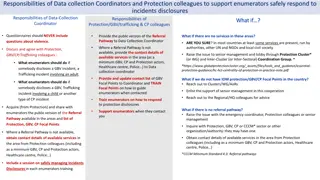Utilizing Financial Indicators in CAHMPAS for State Flex Coordinators
Explore how State Flex Coordinators can leverage financial indicators in CAHMPAS to assess the financial performance of Critical Access Hospitals (CAHs) in their state, identify strengths and weaknesses, and tailor interventions effectively. This primer details the process of using financial data to target Flex funds strategically and improve the financial condition of CAHs.
Download Presentation

Please find below an Image/Link to download the presentation.
The content on the website is provided AS IS for your information and personal use only. It may not be sold, licensed, or shared on other websites without obtaining consent from the author. Download presentation by click this link. If you encounter any issues during the download, it is possible that the publisher has removed the file from their server.
E N D
Presentation Transcript
A Primer on How State Flex Coordinators Can Use the Financial Indicators in CAHMPAS CAHMPAS Team North Carolina Rural Health Research and Policy Analysis Center Cecil G. Sheps Center for Health Services Research 725 Martin Luther King, Jr. Boulevard Chapel Hill, NC 27514 monitoring@flexmonitoring.org Funded by: Cooperative Agreement for the National Evaluation of the Rural Hospital Flexibility Program. Technical and Non-Financial Assistance for the Office of Rural Health Policy, HRSA, U.S. DHHS (PHS Grant No. U27RH01080), 7/1/2018-6/30/2023, $1,480,000. A Performance Monitoring Resource for Critical Access Hospitals, States, and Communities
Purpose To highlight the financial indicators in CAHMPAS To describe how Flex Coordinators can use the information to assess the financial performance and condition of CAHs in their state To illustrate how to identify financial strengths and weaknesses for the design of interventions and targeting of Flex funds by Flex Coordinators 2
Contents 1. Introduction to CAHs 2. Overview of CAHMPAS 3. How to measure CAH financial performance using the Indicators 4. How to compare CAH financial performance using peer groups 5. How to evaluate CAH financial performance using benchmarks 6. How SFCs can use the financial indicators in CAHMPAS: an example 7. Limitations 8. What is next? 3
Sources of Revenue to CAHs Medicare 73% of inpatient revenue 37% of outpatient revenue Medicaid Commercial payers Self-pay Contributions Grants Local government 5
Legislation Legislation enacted as part of the Balanced Budget Act (BBA) of 1997 authorized states to establish State Medicare Rural Hospital Flexibility Programs (Flex Program), under which certain facilities participating in Medicare can become Critical Access Hospitals (CAH). 6
Differences from PPS CAHs receive Cost Based Reimbursement - 99% of allowable costs for Medicare beneficiaries That is, NOT the Inpatient Prospective Payment System (IPPS) and Hospital Outpatient Prospective Payment System (OPPS). Acommon misconception is that CAHs receive 99% of all costs instead of Medicare costs. 7
Criteria to be a CAH Be located in a state that has established a State Flex Program (as of December 2008, only CT, DE, MD, NJ, and RI did not have such a program); Be located in a rural area or be treated as rural under a special provision that allows qualified hospital providers in urban areas to be treated as rural for purposes of becoming a CAH; Furnish 24-hour emergency care services, using either on-site or on-call staff; 8
Criteria to be a CAH Provide no more than 25 inpatient acute care beds that can be used for either inpatient or swing bed services. A swing bed can be used to provide either acute or skilled nursing facility care. A CAH may also operate a distinct part rehabilitation or psychiatric unit, each with up to 10 beds; Have an average annual length of stay of 96 hours or less; 9
Criteria to be a CAH Be located either more than 35 miles from the nearest hospital or CAH or more than 15 miles in areas with mountainous terrain or only secondary roads OR prior to January 1, 2006 were State certified as a necessary provider of health care services to residents in the area. 10
Allowable Costs Payment for inpatient or outpatient CAH services is NOT subject to the following reasonable cost principles: Lesser of cost or charges; and Reasonable compensation equivalent limits. In addition, payment to a CAH for inpatient services is not subject to ceilings on hospital inpatient operating costs or the preadmission payment window provisions applicable to hospitals paid under the Inpatient Prospective Payment System and Outpatient Prospective Payment System. 11
Medicare Cost Report Financial Indicators in CAHMPAS are derived from data in the Medicare Cost Report, which is publicly available for every hospital receiving Medicare reimbursement Timing, data quality can be an issue The Medicare Cost Report contains wealth of data on key variables such as total gross charges (list price), gross and net revenues, expenses, patient visits, payer mix (how many patients have Medicare, Medicaid) 12
Medicare Cost Report The report is very long, several hundreds of pages, and may reach into the thousands with supporting documents. The report is divided into worksheets. The website below explains the various worksheets and what data go into each block. http://www.costreportdata.com/worksheet_formats. html 13
Interim Rate and Settlement Process A CAH s initial payment rates are based on the last cost report filed as an acute care hospital Any fluctuation between the interim rates set and paid throughout the year, and the actual costs for the year, is reflected in the end-of-year cost report settlement. If Medicare paid too much, the CAH must repay some money to the program. If Medicare s estimated payments are less than what the cost report says they should have been, the hospital will receive additional payment from Medicare. 14
2. Overview of the Financial Indicators in CAHMPAS 15
Purpose of Financial Indicators One of the most important characteristics of a CAH is its financial performance and condition We want to know whether a CAH has the financial capacity to meet its mission Financial indicators are single numbers that: Have easily interpretable financial significance Facilitate comparisons Results sometimes focus on financial strengths and weaknesses 16
Interpreting Indicators A single indicator value has little meaning: One point in time that may not be representative Can t tell if it is better or worse than other hospitals Therefore, two techniques are commonly used to help interpret the numbers : Trend (time series) analysis Comparative (cross-sectional) analysis Both techniques are used in CAHMPAS 17
Financial Indicators Help to identify: Questions to ask Issues to address Problems to solve Do not necessarily provide Answers Explanations Solutions 18
Evolution of CAHMPAS How to measure CAH performance1 Indicator selection principles, data quality and availability, and performance metrics How to compare CAH performance2 Peer groups as a meaningful basis for performance comparisons How to evaluate CAH performance3 Relative (medians) or absolute (benchmarks) 1. Pink GH, Holmes GM, D Alpe C, McGee P, Strunk. L, Slifkin RT. Financial Indicators for Critical Access Hospitals. Journal of Rural Health 22(3):229-236, Summer 2006 2. Pink GH, Holmes GM, Thompson RE, Slifkin RT. Variations in Financial Performance Among Critical Access Hospitals. Journal of Rural Health 23(4), 299-305, Fall 2007 3. Pink GH, Holmes GM, Slifkin RT, Thompson RE. Developing Financial Benchmarks for Critical Access Hospitals,Health Care Financing Review 30(3), Spring 2009 19
Objectives of the Financial Indicators in CAHMPAS To select and construct a set of financial performance measures that are relevant to CAHs To provide comparative information that CAH boards and administrators can use to improve financial performance To improve the quality of Medicare Cost Report data reported by CAHs (our goal) 20
Financial Ratios in CAHMPAS Profitability indicators measure the ability to replace buildings and equipment, meet increases in service demands, and compensate investors Total margin, cash flow margin, return on equity Liquidity indicators measure the ability to pay bills in a timely manner Current ratio, days cash on hand, days in net accounts receivable, days in gross accounts receivable 21
Financial Ratios in CAHMPAS Capital structure indicators measure the extent of debt and equity financing Equity financing, debt service coverage, long-term debt to capitalization Outpatient indicators measure the amount of revenues and expenses that are from outpatient services Outpatient Revenue to Total Revenue, Hospital Medicare Outpatient Payer Mix, Hospital Medicare Outpatient Cost to Charge 22
Financial Ratios in CAHMPAS Inpatient indicators measure the amount of revenues, expenses, and utilization that are from inpatient services Medicare Inpatient Payer Mix, Medicare Inpatient Cost per Day, Acute Average Daily Census, Swing Average Daily Census Growth indicators measure the amount of growth in operating revenue and expenses for 1 and 3 years 1-Year Change in Operating Revenue, 3-Year Change in Operating Revenue, 1-Year Change in Operating Expense, 3-Year Change in Operating Expense 23
Financial Ratios in CAHMPAS Labor indicators measure workforce metrics FTE per Adjusted Occupied Bed, Average Salary per FTE, Salary to Net Patient Revenue Other indicators measure additional metrics not classified by the other domains Average Age of Plant, Patient Deductions, Medicaid Payer Mix, Uncompensated Care, Reinvestment
3. How to measure CAH financial performance using the indicators Pink GH, Holmes GM, D Alpe C, McGee P, Strunk. L, Slifkin RT. Financial Indicators for Critical Access Hospitals. Journal of Rural Health 22(3):229-236, Summer 2006. 25
Profitability: Total Margin Net income Total revenue Definition Measures the percent of total revenues that is profit or loss. A positive value indicates total expenses are less than total revenues (a profit). Very high positive values may indicate higher patient volumes, which drive down the cost per unit of service. A negative value indicates total expenses are greater than total revenues (a loss). Very high negative values may indicate financial difficulty. Interpretation 2018 CAH median 1.61% 26
Profitability: Cash Flow Margin Definition Net income (Contributions, investments, and appropriations + Depreciation expense + Interest expense) Net patient revenue + Other income Contributions, investments, and appropriations Measures the cash inflow per dollar of revenue from providing patient care services. A positive value indicates cash outflows are less than cash inflows. A negative value indicates cash outflows are greater than cash inflows. Interpretation 2018 CAH median 5.71% 27
Profitability: Return on Equity Definition Net income Net assets Measures the net income generated by equity. In a not-for profit entity, equity is the sum of federal, state, and local grants, contributions, and the accumulated earnings of the hospital. A positive value indicates net income was generated by equity. Very high positive values may indicate an opportunity for debt financing. A negative value indicates a net loss was generated by equity. Very high negative values may indicate financial difficulty. Interpretation 2018 CAH median 4.24% 28
Profitability: Operating Margin Net patient revenue + other revenue total operating expense Net patient revenue + other revenue Definition Measures the percent of operating revenues that is profit or loss. A positive value indicates operating expenses are less than operating revenues (an operating profit). Very high positive values may indicate higher patient volumes, which drive down the cost per unit of service. A negative value indicates operating expenses are greater than operating revenues (an operating loss). Very high negative values may indicate financial difficulty. Interpretation .17% 2018 CAH median 29
Liquidity: Current Ratio Current assets Current liabilities Definition Measures the number of times short-term claims can be paid from assets that are expected to be converted to cash in the short-term. A value greater than 1.0 indicates current assets are greater than current liabilities. Very high values may indicate underinvestment in longer-term assets that usually yield higher returns. A value less than 1.0 indicates current assets are less than current liabilities. Very low values may indicate financial difficulty. Interpretation 2018 CAH median 2.54 times 30
Liquidity: Days Cash on Hand Cash + temporary investments + investments (Total expenses Depreciation) / Days in period Definition Measures the number of days an organization could operate if no cash was collected or received. A low value indicates only a few days of cash on hand. Very low values may indicate financial difficulty. A high value indicates many days of cash on hand. Very high values may indicate under-investment in longer-term assets that usually yield higher returns. Days Cash on Hand is calculated at fiscal year end, which does not reflect uneven cash flows throughout the year. Interpretation 2018 CAH median 75.88 days 31
Liquidity: Days in Net Accounts Receivable Net patient accounts receivable (Net patient revenue) / Days in period Definition Measures the number of days that it takes an organization, on average, to collect the money its is owed. A high value indicates many days to collect receivables. Very high values may indicate a need to review collection policies and procedures. A low value indicates only a few days to collect receivables and may indicate a more efficient system for processing accounts receivable, higher Medicare and Medicaid payer mix, offering of long-term care services, or some combination. Interpretation 2018 CAH median 50.68 days 32
Liquidity: Days in Gross Accounts Receivable Gross patient accounts receivable (Gross patient revenue) / Days in period Definition Days in gross accounts receivable compared to days in net accounts receivable measures revenue cycle performance. Days in gross and net accounts receivable that are close in value indicate good revenue cycle performance. Days in gross accounts receivable greater than days in net accounts receivable may indicate that the allowances for doubtful accounts require analysis and possible adjustment. Interpretation 20178CAH median 49.06 days 33
Capital Structure: Equity Financing Net assets Total assets Definition Measures the percentage of total assets financed by equity. In a not-for profit entity, equity is the sum of federal, state and local grants, contributions, and the accumulated earnings of the hospital. A value greater than 50 percent indicates that more of the assets are financed by equity than by debt. Very high values may indicate opportunities for debt financing. A value less than 50 percent indicates that more of the assets are financed by debt than by equity. Very low values may indicate exposure to financial risk because debt service is a fixed charge. Interpretation 59.69 % 2018 CAH median 34
Capital Structure: Debt Service Coverage Net income + Depreciation + Interest expense Notes and loans payable (short term) * (365/DIP) + Interest expense where DIP means days in period Definition Measures the cash inflow per dollar of principal payments and interest expense. A positive value greater than 1.0 indicates cash flow greater than current fixed charge payments. Very high positive values may indicate an opportunity for debt financing. A positive value less than 1.0 or a negative value indicates cash flow less than current fixed charge payments. Very low values may signal a need to reassess debt policies. Refinancing may be an option if interest rates are lower in the current period than when the original debt financing occurred. Interpretation 2018 CAH median 3.43 times 35
Capital Structure: Long-Term Debt to Capitalization Long-term debt Long-term debt + Net assets Definition Measures the percentage of total capital that is debt. A value greater than 50 percent indicates that a majority of capital is debt. Very high values may indicate exposure to financial risk because debt service is a fixed charge. A value less than 50 percent indicates that the majority of capital is equity. Very low values may indicate opportunities for debt financing. Interpretation 2018 CAH median 30.83 % 36
Outpatient: Outpatient Revenues to Total Revenues Total outpatient revenue Total patient revenue Definition Measures the percentage of total revenues that is for outpatient services (including, for example, Rural Health Clinics, free- standing clinics, and home health clinics). A value greater than 50 percent indicates that the majority of total patient revenues is for outpatient services. A value less than 50 percent indicates that the majority of total patient revenues is for inpatient services. Interpretation 2018 CAH median 79.40 % 37
Outpatient: Hospital Medicare Outpatient Payer Mix Hospital Outpatient Medicare charges Hospital total outpatient charges Definition Measures the percentage of total outpatient charges that is for Medicare patients. A value greater than 50 percent indicates that the majority of outpatient charges is for Medicare patients. Very high values may indicate lack of financial diversification due to high dependence on Medicare reimbursement. A value less than 50 percent indicates that the majority of outpatient charges is for Medicaid, privately insured, and other patients. Interpretation 37. 13% 2018 CAH median 38
Outpatient: Hospital Medicare Outpatient Cost to Charge Hospital Medicare Outpatient Costs Hospital Medicare Outpatient Charges Definition Measures the outpatient Medicare costs per dollar of outpatient Medicare charges. A value less than 0.5 indicates that Medicare outpatient costs are less than one half of Medicare outpatient charges. Very low values may indicate patient volume is relatively high, gross charges are relatively high, costs are relatively low, or some combination of these factors. A value greater than 0.5 indicates that Medicare outpatient costs are greater than one half of Medicare outpatient charges. Very high values may indicate low volume, an inadequate rate structure, an opportunity to review operating costs, or some combination. Interpretation 2018 CAH median 43.51 % 39
Inpatient: Medicare Inpatient Payer Mix Medicare inpatient days Definition Total inpatient days Nursery bed days NF Swing bed days Measures the percentage of total inpatient days that is provided to Medicare patients. A value greater than 50 percent indicates that the majority of inpatient days is for Medicare patients. Very high values may indicate lack of financial diversification due to high dependence on Medicare reimbursement. A value less than 50 percent indicates that the majority of inpatient days is for Medicaid, privately insured, and other patients. Interpretation 2018 CAH median 71.94% 40
Inpatient: Medicare Acute Inpatient Cost per Day Definition Medicare acute inpatient cost (Medicare Inpatient Days (excl. HMO)) Measures the average daily cost of a Medicare acute inpatient. Skilled nursing facility days are excluded. A high value indicates a higher cost per day (and thus a higher amount of Medicare revenue per day). A low value indicates a low cost and amount of Medicare revenue per day. Medicare Acute Inpatient Cost per Day is influenced by facility occupancy rates, utilization of services, and the ability to manage costs. $2830 Interpretation 2018 CAH median 41
Inpatient: Average Daily Census Swing-SNF Beds Inpatient swing bed SNF days Days in period Definition Measures the average number of swing beds occupied per day. A high value indicates high use of swing-SNF beds. A low value indicates low use of swing-SNF beds. Average Daily Census Swing-SNF Beds is influenced by the number of swing-SNF beds available. Interpretation 1.53 beds 2018 CAH median 42
Inpatient: Average Daily Census Acute Beds Inpatient acute care bed days Days in period Definition Interpretation Measures the average number of acute care beds occupied per day. A high value indicates high use of acute care beds. A low value indicates low use of acute care beds. Average Daily Census Acute Beds will be influenced by the number of acute care beds available. 2018 CAH median 2.54 beds 43
Growth: 1-Year Change in Operating Revenue Operating revenue (year t)- Operating revenue (year t-1) Operating revenue (year t-1) Measures the 1-year percentage change in operating revenue. Positive values indicate increase in operating revenue and negative values indicate decreases in operating revenue over a 1-year time period. Growth in operating revenue greater than growth in operating expenses results in higher profitability as measured by operating margin. Growth in operating revenue less than growth in operating expenses results in lower profitability. Definition Interpretation 2018 CAH median 3.9 % 44
Inpatient: 3-Year Change in Operating Revenue Operating revenue (year t)- Operating revenue (year t-3) Operating revenue (year t-3) Measures the 3-year percentage change in operating revenue. Positive values indicate increase in operating revenue and negative values indicate decreases in operating revenue over a 3-year time period. Growth in operating revenue greater than growth in operating expenses results in higher profitability as measured by operating margin. Growth in operating revenue less than growth in operating expenses results in lower profitability. Definition Interpretation 2018 CAH median 11.5 % 45
Growth: 1-Year Change in Operating Expenses Operating expenses (year t) Operating expenses (year t-1) Operating expenses (year t-1) Definition Measures the 1-year percentage change in operating expense. Positive values indicate increase in operating expense and negative values indicate decreases in operating expense over a 1-year time period. Growth in operating revenue greater than growth in operating expenses results in higher profitability as measured by operating margin. Growth in operating revenue less than growth in operating expenses results in lower profitability. Interpretation 2018 CAH median 3.7 % 46
Growth: 3-Year Change in Operating Expense Operating expenses (year t)- Operating expenses (year t-3) Operating expenses (year t-3) Measures the 3-year percentage change in operating expense. Positive values indicate increase in operating expense and negative values indicate decreases in operating expense over a 3-year time period. Growth in operating revenue greater than growth in operating expenses results in higher profitability as measured by operating margin. Growth in operating revenue less than growth in operating expenses results in lower profitability. Definition Interpretation 13.8 % 2018 CAH median 47
Labor: Salaries to Net Patient Revenue Salary expense Net patient revenue Definition Measures the percentage of net patient revenue that is for salaries. Very high values may indicate labor intensive organizations, employment of medical staff, or old plant and equipment. A value less than 50 percent indicates that the majority of net patient revenue is for supplies, equipment, and other expenses. Very low values may indicate capital- intensive organizations or new plant and equipment. Interpretation 2018 CAH median 45.10 % 48
Labor: FTEs per Adjusted Occupied Bed Number of FTEs Adjusted occupied beds** Definition Measures the number of full time employees per each occupied acute care bed. A high value indicates many employees per bed. Very high values may indicate low volume and a potential opportunity to evaluate staff productivity. A low value indicates a few employees per bed. Very low values may indicate high volume or a high level of staff productivity. Interpretation 2018 CAH median 5.56 FTEs ** (Inpatient days NF Swing days Nursery days) * (Total patient revenue / (Total inpatient revenue Inpatient NF revenue Other LTC Revenue)) / Days in period 49
Labor: Average Salary per FTE Salary Expense Number of FTEs Definition Measures the price and mix of labor. A high value indicates that a hospital pays above average wages / salaries and / or employs relatively more high skill occupations and / or experienced staff. A low value indicates a hospital pays below average wages / salaries and / or employs relatively fewer high skill occupations and / or experienced staff. Interpretation 2018 CAH median $ 59370 50




